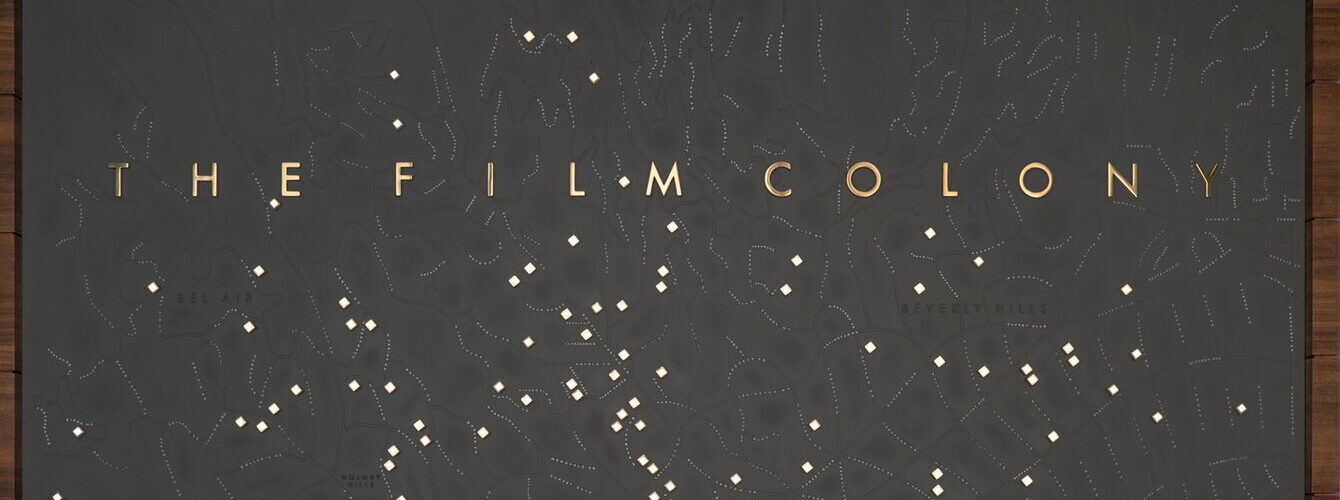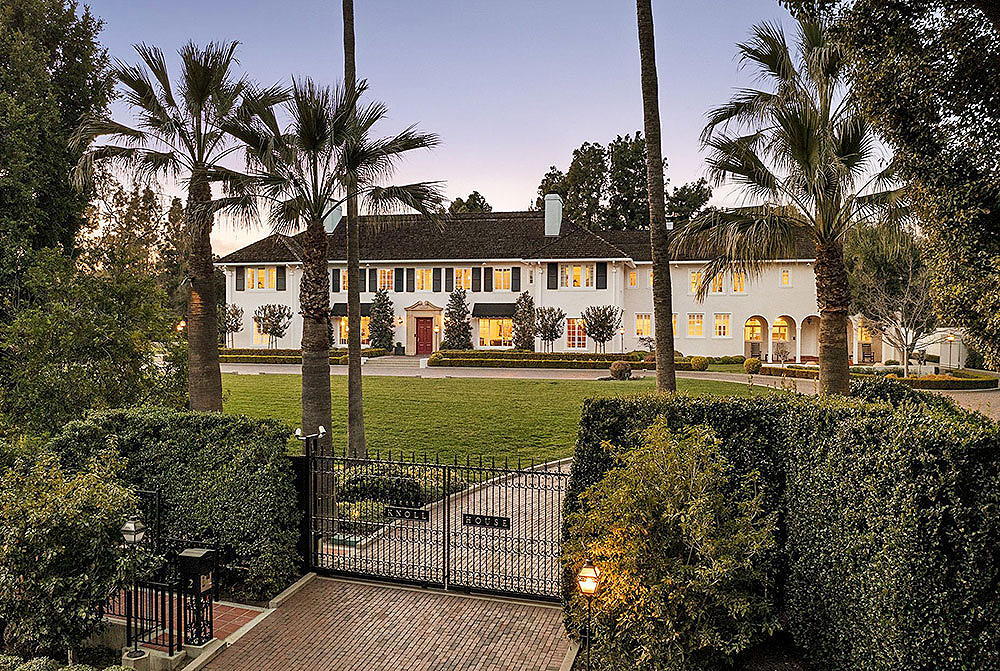
The complex and inventive works of artist Matt Locke are currently enjoying a private exhibition at Knoll House, located in a private cul-de-sac in Pasadena: Oak Knoll Terrace in Pasadena.
Knoll House is the former residence of heiress, art collector, and philanthropist Virginia Steele Scott and was designed by architect Myron Hunt. Located near the Langham Hotel in Pasadena, the magnificent property boasts a stately mansion with a separate custom-built museum.
This collection of Locke’s recent multi-media works, entitled The End Is Here, is available for viewing in the museum by appointment only.
Knoll House in Pasadena was originally designed in 1916 by architect Myron Hunt (who also designed the Huntington Library) and later expanded by architect Gordon Kauffman. Art collector and philanthropist Virginia Steele Scott hired modernist architects Ladd & Kelsey (who also designed the Norton Simon Museum) in 1971 to design a private museum on estate grounds, and renamed the estate Knoll House. The house recently underwent a seven-year restoration, and was upgraded with high-tech amenities.
The Knoll House estate has been tastefully renovated and decorated, and is currently on the market for a cool $38.5 million.
Currently adorning the walls of this elegant museum are the diverse artworks created by Locke. The works, as a group, express Locke’s fascination with glamor and legend, capturing the allure of the disco era’s significant mecca—the Studio 54 nightclub in NYC—to the glamor of old Hollywood of Beverly Hills.
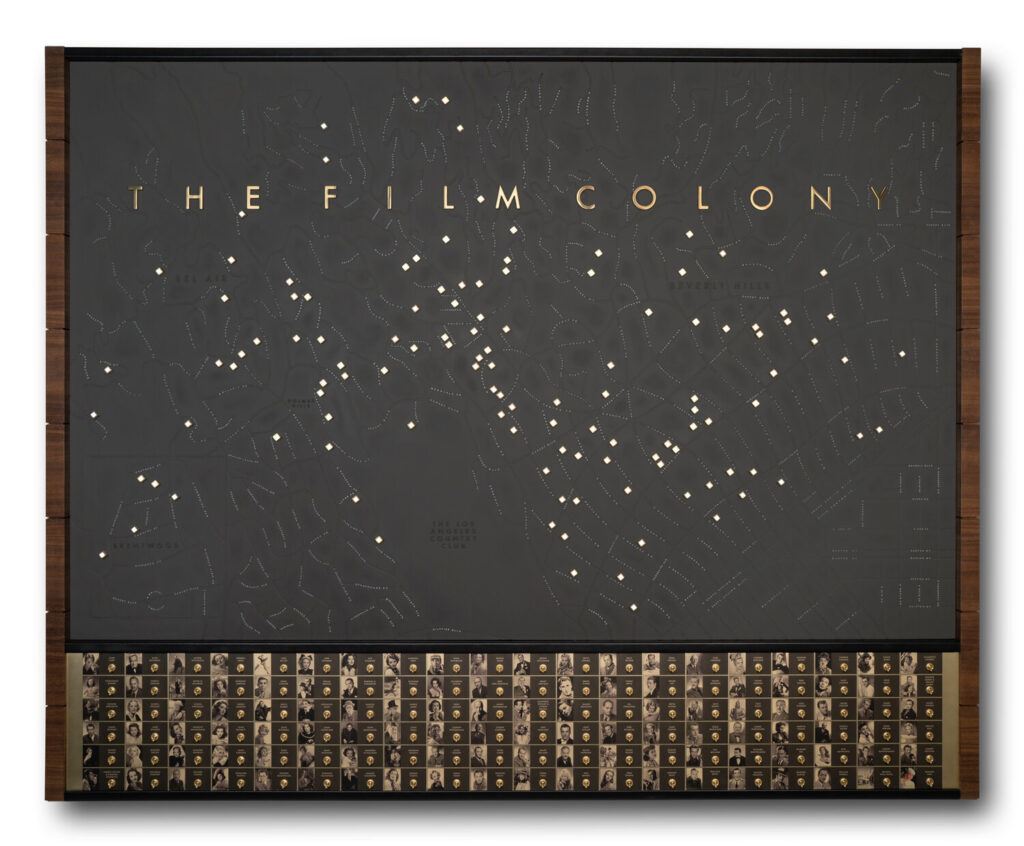
An illuminated star map. The homes of Golden Age Hollywood stars, 1938 to 1954, marked on a map of Beverly Hills & Bel-Air, lit by LEDs, controlled on a toggle switchboard.
Brass, leather, walnut, MDF, acrylic, LEDs. 78” X 62”
More accurately described as installations, Locke combines woodwork, architecture, electronics, and collage in pieces that explore the tension between the substantial and the superficial. By building layers of mixed media, Matt’s three-dimensional wall sculptures superimpose American pop culture tropes onto maps and textured terrain to examine how media saturation and marketing distract from the true workings of the political, financial, and corporate systems that control actual power. Matt also mines his collection of photographs, taken worldwide, to produce geometric collages that investigate humans’ relationships with their machines (Eyes of the Beholder) and how limited or misinterpreted information at the beginning leads to significant perturbation in chaotic systems (Chaos Theory).
“In what could be the most enlightened time in human history, with the world’s knowledge in our phones, we descend into tribalism and ignorance. During fever-dreams of nostalgia for lost era, the artist forged these layered and tactile expressions of human potential, a celebration of what was and what could be, told in wood, leather, metal, photographs, and light.”
Artist statement on the mixed media art on display at Knoll House, The End Is Here.
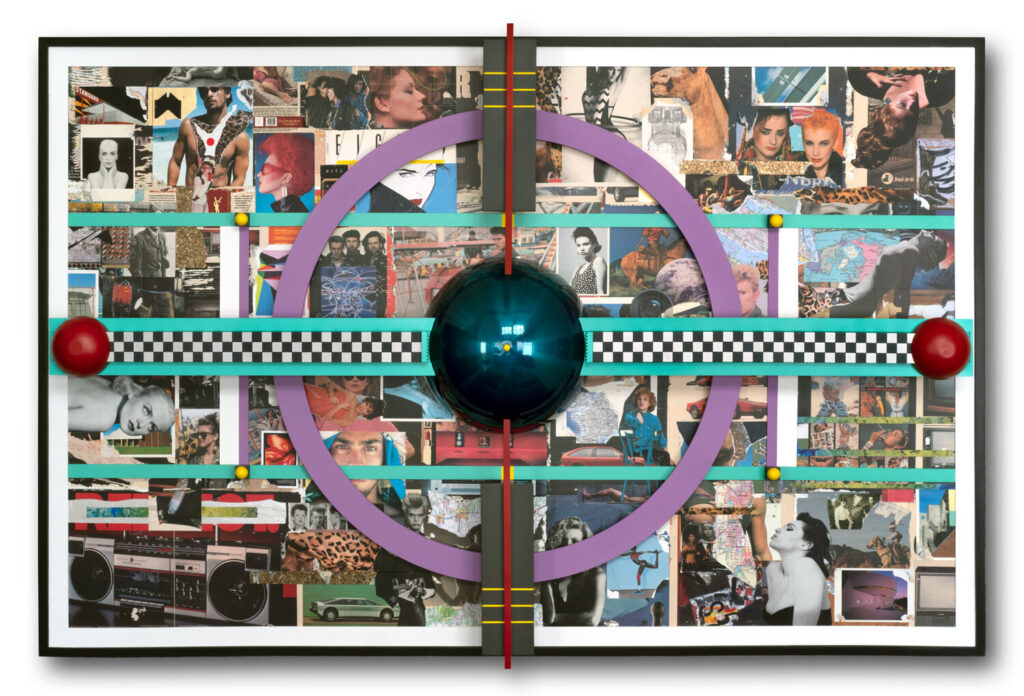
Memphis-school architectural elements. Vintage magazines and postcards. ‘80s superstars including Annie Lennox & French siren Beatrice Dalle. Wood, brass, aluminum, magazines, LEDs. 72” X 48”
The location of this exhibition is intrinsic to the works contained within it. Granting me a private tour, Locke enthusiastically regales me with the rich history of the place.
Matt Locke: “The main house was built in 1916, and was designed by Myron Hunt. He’s the same architect who designed the mansion that became the Huntington Museum. So, in the Gilded Age, he was the go-to architect for the rich, meaning during the early 1900s, well, late 1800s to about 1927.
“He mostly worked a lot in Los Angeles. There was a lot of railroad money, oil money, and the wealthy liked Pasadena. They came here, these East Coasters, because they come from snowy, cold climates—these were their winter homes, usually.”
Many of the mansions were traditional Beaux Arts style of architecture, featuring a grand entrance and elegant symmetry.
Adds Locke, “It’s all about showing off your wealth, as well as having a really nice place to chill for the winter, with an orange tree in the backyard. The house that became the Huntington was a winter home, and maybe the Langham, too.
“This house was built and then in the 70s, it was owned by a very wealthy socialite called Virginia Steel Scott. And she had a massive art collection that she had accrued. She was a painter, herself. She toured Europe. It was that kind of thing that rich people do, right? They love to collect. She acquired this big collection and so she built another property.
“This lot is over two and a half acres. She’s in this house and she thinks, what do I do with that space? I need to build my own museum. And this is in the 70s. So she hires the big architects of that day, who are Kelsey and Ladd. They’re the same architects who did the Norton Simon Museum. She selected the pre-eminent museum architects of her day. Well, you can’t get a permit for this. There’s no way that the city of Pasadena wants a fully functioning Museum in a residential cul de sac, because they don’t want the traffic. She lied on the permit and said it was an exercise facility. The city approved it and then they started building. This museum is 20,000 square feet. This is almost twice as big as the house—almost.
“As far as we can tell, she never used it as a museum. We don’t even know how much of her art was here. However, it was right after that, in 1973, that this structure was completed. This is sometimes called the Virginia Steel Scott Museum. But she gave her entire art collection and a bunch of money to the Huntington.
“She probably thought, ‘I could make this a museum but then I’m going to have trouble with the traffic and visitors, and it’s just not going to work.’ So she switches gears, I guess, and decides you know what? I want people to see my collection. I have a fabulously curated collection. Let’s build a whole wing and make it accessible.”
But then what happens to this house?
“A relative of hers that might have been her nephew – I don’t know the relationship – but he was a televangelist and he lived here in the 80s. He had so much cash from his church that there were armed guards on the property.
“The current owner hired a stager who came in and did a gorgeous job in the house. Every room of this house is furnished beautifully. He was tasked with making this look like a world class museum, which it is!”
Are you the first artist to have their work here?
“I don’t know if I’m the first, but I’m certainly one of the artists that was selected to make this look like it’s 100% legit and so my work is here.”
On how many levels is your art being displayed right now?
“There’s an atrium, forty-feet tall. This is dug into the ground. That’s right below ground level here. The proportions of this place are true museum proportions. I mean, you would never know, walking in here, that you’re in a residence in Pasadena. Never. You’re in a beautiful museum that’s beautifully appointed within and it’s comfortable and it’s welcoming. And it’s also a great showcase for exhibitions.
“My work is here. And we’re also featuring the paintings of Jennifer King as part of the exhibition. The pieces that you’re seeing today is the first collection I’ve done since 2005 that were not commissions; they poured out of my soul. I made these works against the backdrop of tremendous loss because in that time that these started to be created, we had COVID, my Dad died, my man left me…
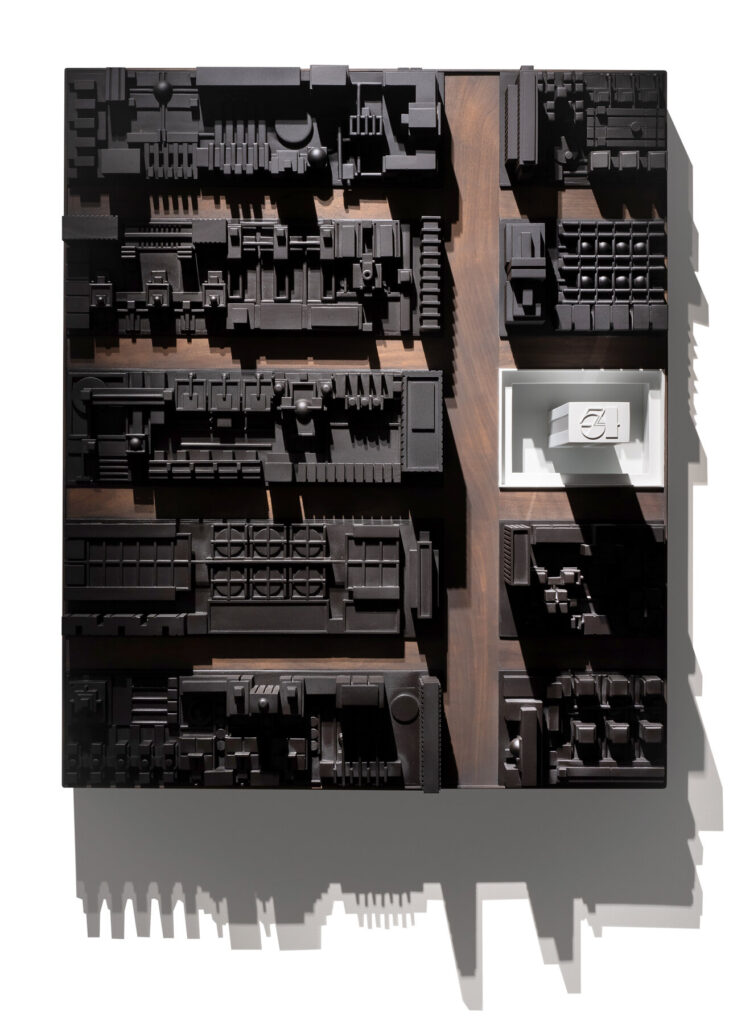
Map of midtown Manhattan, 8th Ave & 54th St. Hand-constructed basswood buildings. Studio 54 as a lighthouse.
Walnut, basswood, LEDs. 34” X 42”
“These two pieces are the oldest, they come from the 2010s. All of the new ones got finished last year (2022). I’m obsessed with Studio 54, the nightclub in New York City. I was born in ’69 and it closed before I could go there (was it was open from 1977 to 1981). Besides, I was in Colorado. I knew about it as a kid, that it was a legendary place. I probably found out about it from People magazine. What I wanted was to grow up and hang out with Andy Warhol and live in New York City and make art and have a big job in this scene with a concrete floor that I hose down. I see Studio 54 as a beacon of hedonism and glamor and sexual liberation, before I even knew what those things were.
“This is not a document. This is an artistic interpretation of a real place. Yeah, that is their logo as you know, but is it really that tall a building? No.
“All of this art has a common theme, which is me adding order to a system. I love to arrange things. I loved Lego as a kid. I love putting things together. This is a little bit like a haiku where I had some pre-made shapes like these. And I had a whole bunch of them, then I used Google Earth to create the exact proportions of the city blocks. It has such a point of prominence, which is the poet’s interpretation. It’s phallic and it’s a skyscraper – a lighthouse.
“A lot of the art represents nostalgia for a lost era. All the hedonism and glamor before AIDS killed everybody.”
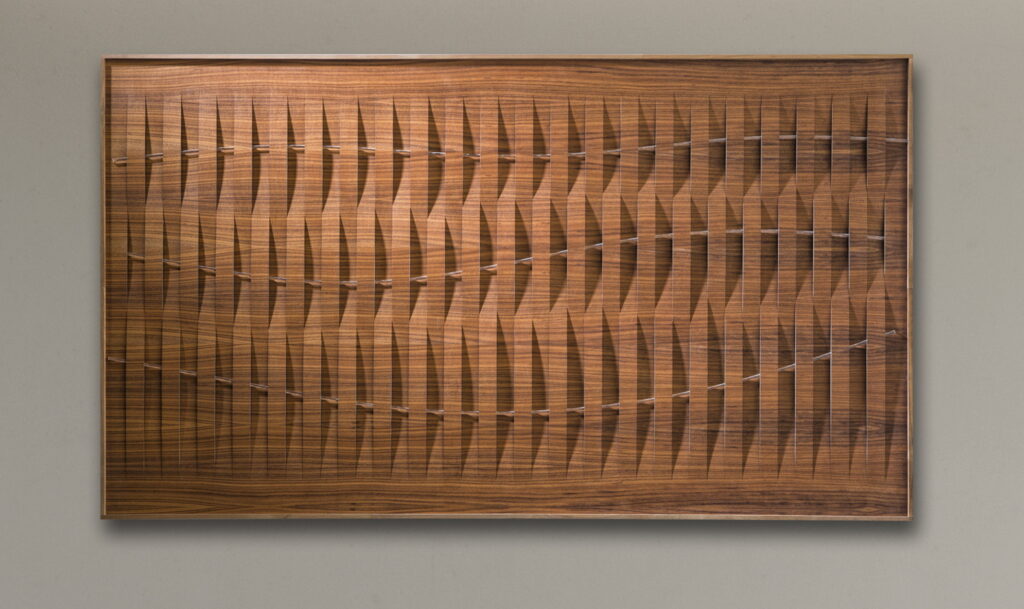
Walnut veneer sliced in strips, threaded with clear acrylic rods.
Walnut, acrylic, LEDs. 69” X 40”
Locke: “This is more of a study in materials because I love working with tools. I love wood and I love the experience of working with it. I wanted to find out if I could do this, and I saw a basket weave and I was actually slicing it. This is a single sheet of walnut veneer, which you can buy anywhere. Have you ever veneered anything? The glue is liquid and you apply it all over the surface and it dries. When it makes contact with itself, it sticks forever, and there’s no moving around. There’s something about that that I love because I love precision veneer work. When I do it, it’s kind of maddening because you get one chance or you might mess it up.”
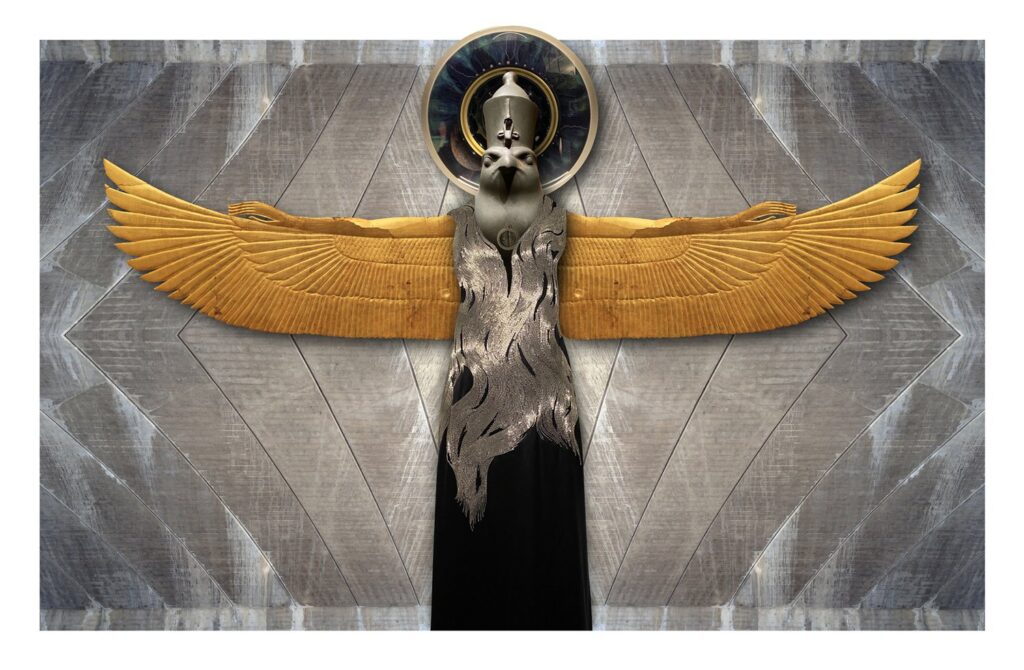
Mineral stains on the underside of a concrete bridge on Sunset Boulevard in Silver Lake, isolated wings from the external sarcophagus of King Tutankhamen photographed in Cairo, granite Egyptian falcon photographed in New York, iris of a giant Pink Floyd plastic eyeball and beaded Alexander McQueen gown photographed in Los Angeles.
Available as prints
“Chaos Theory is math. I don’t understand it as that, but what it was used for is modeling. The whole idea of the butterfly effect where a butterfly flaps its wings… What that really came from was in chaos theory when they’re trying to describe complex systems. They realize it in a mathematical model. If you have some information at the beginning that you put into the system that’s off even the tiniest bit, it will blow up into a huge error later. And they use the analogy of the butterfly wings, but that was never what they meant. So, for me as a historian and a Princeton graduate and someone who tries to be very intentional in the way that I speak and talk, I make things that I have a real connection to. It’s kind of a beautiful example of how little most people put into anything. A lot of us just live on the surface, while artists dig in.
“My Eyes of the Beholder [collage] series were made from my iPhone pictures. They come from my travels around the world. They’re my pictures and then I use Illustrator. I do something that I don’t think other photo artists ever do. Most photo artists are much better in Photoshop than I am. But when you take a figure out of the background that’s called rotoscoping. What I do is – because of the order in Illustrator, it’s vector-based, while in Photoshop, it’s pixel-based. On the line vectors are a mathematical expression. And the line is a it’s math. And it’s scales. So you create a scale from anything to anything. The paths that machines use to cut shapes that I tell them to are always vectors, they are not a photo. If you give them a photo, they’ll have to convert it into a vector. And I love vectors because they’re precise.”
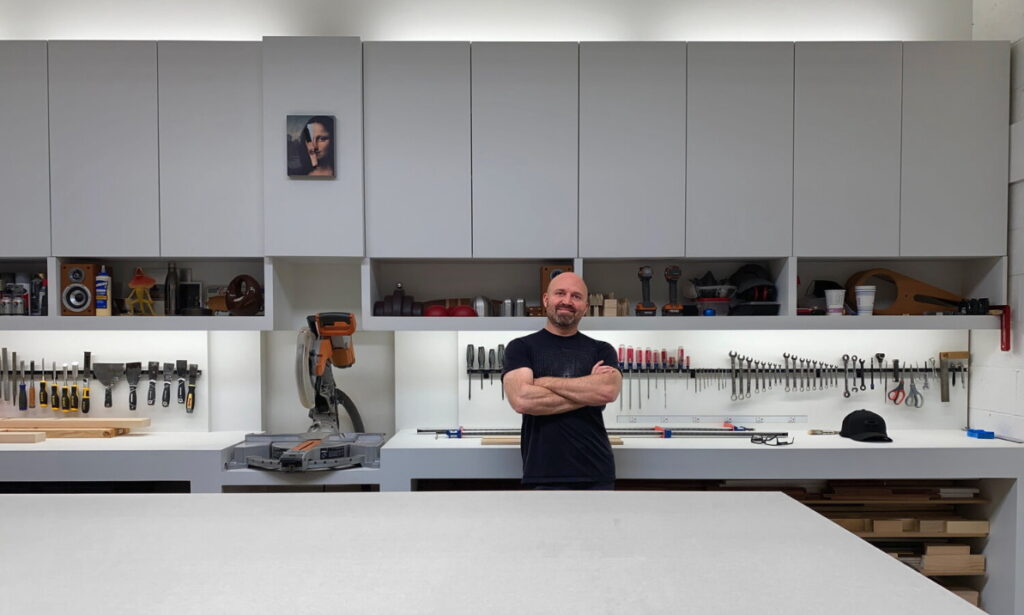
Artist Bio:
Matt Locke (b. 1969, Colorado) received his BA from Princeton (1993) and has leveraged careers in both design and sculpture. Matt was an exchange student in France (1986), studied art for one semester at SCAD (1988), and industrial design for another at the Institute of Design at IIT in Chicago (1993). Matt designed and built his own house in Colorado at age 27, introduced a line of functional sculpture objects as one of eight Emerging Artists at the Cherry Creek Arts Festival in Denver (2004), then relocated to Los Angeles to pursue art and design full-time. Matt appeared on Jeopardy! (2007) and was a finalist on HGTV Design Star (2008). Between 2009 to 2019, Matt created custom commissions for private and corporate clients, including large scale site-specific architectural installations. Matt recently completed a ten-piece collection of mixed media wall sculptures about nostalgia for lost eras (The End Is Here), geometric collages that look at humans’ relationships to their machines (Eyes of the Beholder), and intricate collages examining how limited information upsets complex systems (Chaos Theory). From his studio in Los Angeles, Matt is currently working on a three-piece collection that includes a half-scale replica of a New York City subway car. https://www.instagram.com/artistmattlocke/


